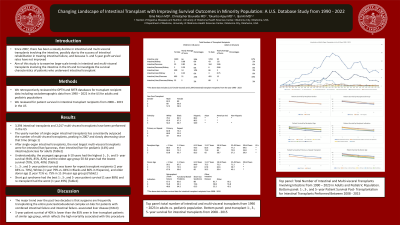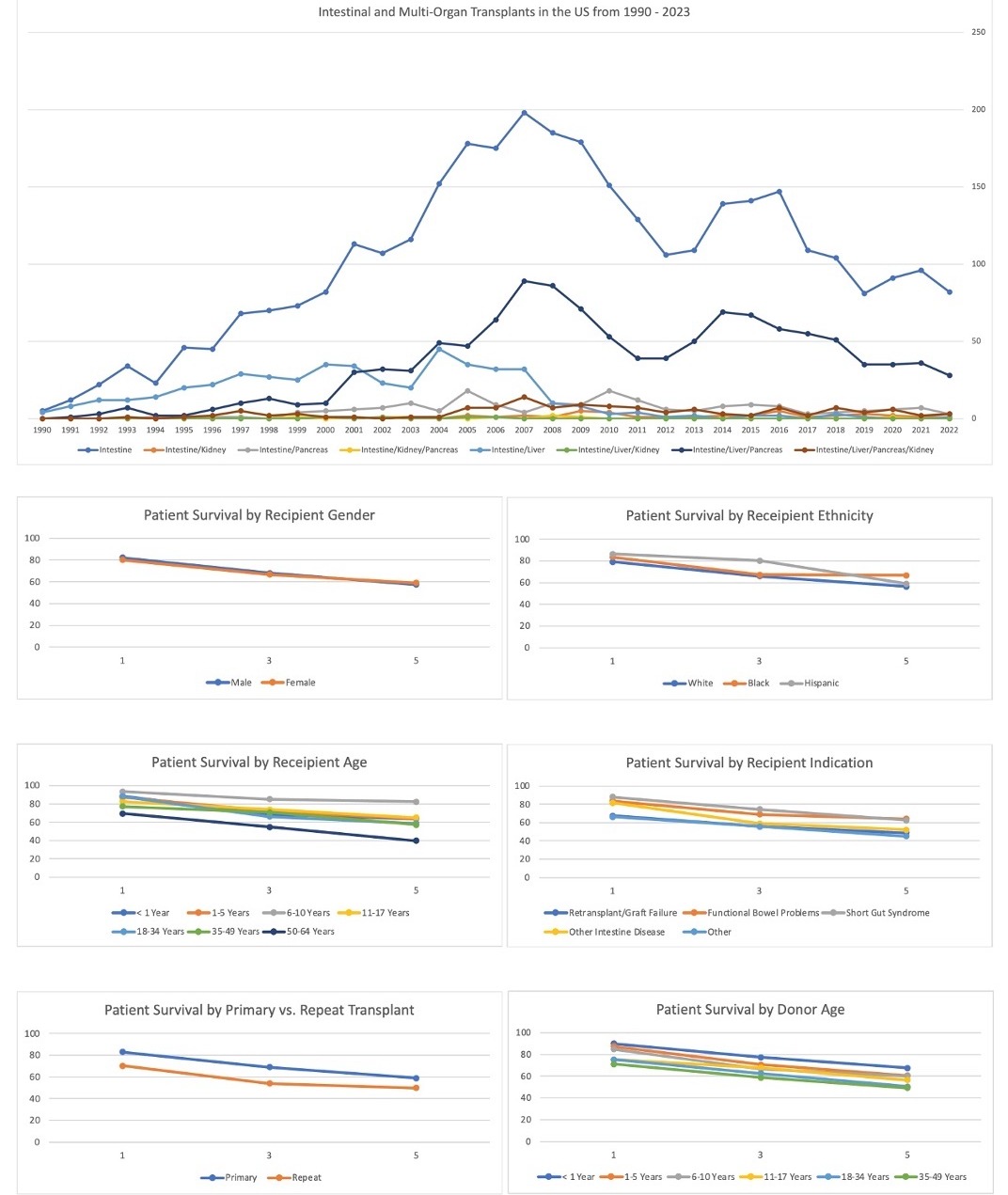Monday Poster Session
Category: Small Intestine
P2641 - Changing Landscape of Intestinal Transplant With Improving Survival Outcomes in Minority Population: A US Database Study From 1990-2022
Monday, October 23, 2023
10:30 AM - 4:15 PM PT
Location: Exhibit Hall

Has Audio

Gina Moon, MD
University of Oklahoma Health Sciences Center
Oklahoma City, OK
Presenting Author(s)
Gina Moon, MD1, Christopher Bouvette, MD2, Tokunbo Ajayi, MD2, Ijlal A. Ali, MD2
1University of Oklahoma Health Sciences Center, Oklahoma City, OK; 2University of Oklahoma College of Medicine, Oklahoma City, OK
Introduction: Since 2007, there has been a steady decline in intestinal and multi-visceral transplants involving the intestine, possibly due to the success of intestinal rehabilitation in treating intestinal failure, and because 3- and 5-year graft survival rates have not improved. The aim of this study is to examine large-scale trends in intestinal and multi-visceral transplants involving the intestine in the US and to investigate the survival characteristics of patients who underwent intestinal transplant.
Methods: We retrospectively reviewed the OPTN and SRTR databases for transplant recipient data including sociodemographic data from 1990 – 2022 in the US for adults and pediatric populations. We reviewed for patient survival in intestinal transplant recipients from 2008 – 2015 in the US
Results: To date, 3,394 intestinal transplants and 2,017 multi-visceral transplants have been performed in the US. The yearly number of single-organ intestinal transplants has consistently outpaced the number of multi-visceral transplants, peaking in 2007 and slowly decreasing since that time (Image1). After single-organ intestinal transplants, the next largest multi-visceral transplants were for intestine/liver/pancreas, then intestine/liver for pediatric (14%) and intestine/pancreas for adults (Table1). The youngest age group 6-10 years had the highest 1-, 3-, and 5- year survival (94%, 85%, 82%) and the oldest age group 50-64 years had the lowest survival (70%, 55%, 40%) (Table1). 1-, 3-, and 5- year patient survival was lower for repeat transplant recipients (1 year 83% vs. 70%), Whites (1 year 79% vs. 84% in Blacks and 86% in Hispanics), and older donor age (1 year 71% vs. 75% in 11-34 year age group) (Table1). Short gut syndrome had the best 1-, 3-, and 5- year patient survival (1 year 88%) and re-transplant had the worst (1 year 49%) (Table1).
Discussion: The major trend over the past two decades is that surgeons are frequently transplanting the entire pancreaticoduodenal complex en bloc for patients with combined intestinal failure and intestinal failure-associated liver disease (IFALD). 5-year patient survival of 40% is lower than the 85% seen in liver transplant patients of similar age group, which reflects the high mortality associated with this procedure. Further research to determine factors that affect Intestinal transplant survival is needed.

Disclosures:
Gina Moon, MD1, Christopher Bouvette, MD2, Tokunbo Ajayi, MD2, Ijlal A. Ali, MD2. P2641 - Changing Landscape of Intestinal Transplant With Improving Survival Outcomes in Minority Population: A US Database Study From 1990-2022, ACG 2023 Annual Scientific Meeting Abstracts. Vancouver, BC, Canada: American College of Gastroenterology.
1University of Oklahoma Health Sciences Center, Oklahoma City, OK; 2University of Oklahoma College of Medicine, Oklahoma City, OK
Introduction: Since 2007, there has been a steady decline in intestinal and multi-visceral transplants involving the intestine, possibly due to the success of intestinal rehabilitation in treating intestinal failure, and because 3- and 5-year graft survival rates have not improved. The aim of this study is to examine large-scale trends in intestinal and multi-visceral transplants involving the intestine in the US and to investigate the survival characteristics of patients who underwent intestinal transplant.
Methods: We retrospectively reviewed the OPTN and SRTR databases for transplant recipient data including sociodemographic data from 1990 – 2022 in the US for adults and pediatric populations. We reviewed for patient survival in intestinal transplant recipients from 2008 – 2015 in the US
Results: To date, 3,394 intestinal transplants and 2,017 multi-visceral transplants have been performed in the US. The yearly number of single-organ intestinal transplants has consistently outpaced the number of multi-visceral transplants, peaking in 2007 and slowly decreasing since that time (Image1). After single-organ intestinal transplants, the next largest multi-visceral transplants were for intestine/liver/pancreas, then intestine/liver for pediatric (14%) and intestine/pancreas for adults (Table1). The youngest age group 6-10 years had the highest 1-, 3-, and 5- year survival (94%, 85%, 82%) and the oldest age group 50-64 years had the lowest survival (70%, 55%, 40%) (Table1). 1-, 3-, and 5- year patient survival was lower for repeat transplant recipients (1 year 83% vs. 70%), Whites (1 year 79% vs. 84% in Blacks and 86% in Hispanics), and older donor age (1 year 71% vs. 75% in 11-34 year age group) (Table1). Short gut syndrome had the best 1-, 3-, and 5- year patient survival (1 year 88%) and re-transplant had the worst (1 year 49%) (Table1).
Discussion: The major trend over the past two decades is that surgeons are frequently transplanting the entire pancreaticoduodenal complex en bloc for patients with combined intestinal failure and intestinal failure-associated liver disease (IFALD). 5-year patient survival of 40% is lower than the 85% seen in liver transplant patients of similar age group, which reflects the high mortality associated with this procedure. Further research to determine factors that affect Intestinal transplant survival is needed.

Figure: Image 1: Top panel: Total Number of Intestinal and Multi-visceral Transplants Involving Intestine from 1990 – 2023 in Adults and Pediatric Population. Bottom panel: 1-, 3-, and 5- year Patient Survival Post-Transplantation for Intestinal Transplants Performed Between 2008 - 2015
Disclosures:
Gina Moon indicated no relevant financial relationships.
Christopher Bouvette indicated no relevant financial relationships.
Tokunbo Ajayi indicated no relevant financial relationships.
Ijlal Ali indicated no relevant financial relationships.
Gina Moon, MD1, Christopher Bouvette, MD2, Tokunbo Ajayi, MD2, Ijlal A. Ali, MD2. P2641 - Changing Landscape of Intestinal Transplant With Improving Survival Outcomes in Minority Population: A US Database Study From 1990-2022, ACG 2023 Annual Scientific Meeting Abstracts. Vancouver, BC, Canada: American College of Gastroenterology.
